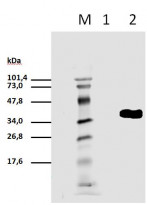ARG65444
anti-CD3 zeta phospho (Tyr111) antibody [EM-55]
anti-CD3 zeta phospho (Tyr111) antibody [EM-55] for Flow cytometry,Western blot and Human,Mouse
Developmental Biology antibody; Immune System antibody
Overview
| Product Description | Mouse Monoclonal antibody [EM-55] recognizes CD3 zeta phospho (Tyr111) |
|---|---|
| Tested Reactivity | Hu, Ms |
| Tested Application | FACS, WB |
| Specificity | The mouse monoclonal antibody EM55 recognizes phosphorylated tyrosine 111 of CD3 zeta chain (CD247), which is a component of TCR/CD3 complex expressed on T cells. |
| Host | Mouse |
| Clonality | Monoclonal |
| Clone | EM-55 |
| Isotype | IgG1 |
| Target Name | CD3 zeta |
| Immunogen | BP1 (pTyr111/123) - KLH |
| Conjugation | Un-conjugated |
| Alternate Names | IMD25; CD3Z; CD3-ZETA; T-cell surface glycoprotein CD3 zeta chain; CD3Q; T-cell receptor T3 zeta chain; CD3H; TCRZ; T3Z; CD antigen CD247 |
Application Instructions
| Application Suggestion |
|
||||||
|---|---|---|---|---|---|---|---|
| Application Note | FACS: Intracellular staining. * The dilutions indicate recommended starting dilutions and the optimal dilutions or concentrations should be determined by the scientist. |
Properties
| Form | Liquid |
|---|---|
| Purification | Purified from cell culture supernatant by protein-A affinity chromatography. |
| Purity | > 95% (by SDS-PAGE) |
| Buffer | PBS (pH 7.4) and 15 mM Sodium azide |
| Preservative | 15 mM Sodium azide |
| Concentration | 1 mg/ml |
| Storage Instruction | For continuous use, store undiluted antibody at 2-8°C for up to a week. For long-term storage, aliquot and store at -20°C or below. Storage in frost free freezers is not recommended. Avoid repeated freeze/thaw cycles. Suggest spin the vial prior to opening. The antibody solution should be gently mixed before use. |
| Note | For laboratory research only, not for drug, diagnostic or other use. |
Bioinformation
| Database Links |
Swiss-port # P20963 Human T-cell surface glycoprotein CD3 zeta chain Swiss-port # P24161 Mouse T-cell surface glycoprotein CD3 zeta chain |
|---|---|
| Gene Symbol | CD247 |
| Gene Full Name | CD247 molecule |
| Background | CD3 complex is crucial in transducing antigen-recognition signals into the cytoplasm of T cells and in regulating the cell surface expression of the TCR complex. T cell activation through the antigen receptor (TCR) involves the cytoplasmic tails of the CD3 subunits CD3 gamma, CD3 delta, CD3 epsilon and CD3 zeta (CD247). These CD3 subunits are structurally related members of the immunoglobulins super family encoded by closely linked genes on human chromosome 11. The CD3 components have long cytoplasmic tails that associate with cytoplasmic signal transduction molecules. This association is mediated at least in part by a double tyrosine-based motif present in a single copy in the CD3 subunits. CD3 may play a role in TCR-induced growth arrest, cell survival and proliferation. |
| Function | Probable role in assembly and expression of the TCR complex as well as signal transduction upon antigen triggering. [UniProt] |
| Highlight | Related products: CD3 antibodies; CD3 ELISA Kits; CD3 Duos / Panels; Anti-Mouse IgG secondary antibodies; Related news: New antibody panels and duos for Tumor immune microenvironment Tumor-Infiltrating Lymphocytes (TILs) |
| Research Area | Developmental Biology antibody; Immune System antibody |
| Calculated MW | 19 kDa |
| PTM | Phosphorylated on Tyr residues after T-cell receptor triggering. |
Images (1) Click the Picture to Zoom In
-
ARG65444 anti-CD3 zeta phospho (Tyr111) antibody [EM-55] WB image
Western blot: 1. Unstimulated HEK293T/17 cell lysate 2. Pervanadate-stimulated HEK293T/17 cell lysate stained with ARG65444 anti-CD3 zeta phospho (Tyr111) antibody [EM-55].
HEK293T/17 cells transiently transfected with expression vector harboring gene for mCD3zeta.






